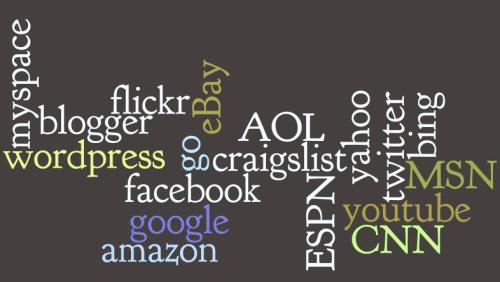Think Like a Search Engine!
Image: freedigitalphotos.net
Are you a small business stuck in the shadows of a big corporation? Or are you that big corporation struggling to get a bigger presence online? Being searchable on the internet is probably one of the most important objectives that a PR practitioner could tell their clients. Ask anyone, and they’ll tell you that they do the majority of their product research online. Quoted from Edelman Digital’s paper on search engine visibility: “There is no greater influence on purchasing decisions and corporate and brand reputation than the links that Google, Yahoo, Windows Live and others list on their first page of search results.” Even now as I was searching for a menu to White Cottage Pizza in my area, it turns out that they don’t have a website for our location available on the first page of Google. In fact, it took an arm and a leg to find a menu for the local establishment. With that, I opted for Pizza Hut. Period.
So what does it take to be more visible on search engines? One tactic is have your website contain words, links, and MORE words and links!
- Search engines search for pure text (not pictures of text) that match your input, so it’s important to think about potential words your searchers will look for. Type in the word “coffee,” and you get one of these sites, full of words, right on the very first page of the search engine.
- Another thing that that particular website contains is lots of links. Search engines love links because they connect other sites to your own site. The more links you have, the more chances that your site will come up in searches, granting more visibility to those in search of a product similar to yours. This page of alleged Ingrid Michaelson fan site links falls terribly short of offering much of them. Of course, I found it on the 3rd page of Google’s search results. By adding several more links to other Ingrid fan sites, search engines will recognize it as a beneficial way to find information.
There are also several other elements that you could incorporate onto your page for more search visibility. By carefully thinking about the word choices you make for search engines to find, you could successfully avoid the competition.
- Programs such as Google Insights can help you figure out what words will be tough to compete with and what similar words can be used instead. Edelman’s paper suggests: “As a general rule of thumb, aim for the ‘magic middle’ – keywords that are searched but aren’t too generic and therefore don’t face a lot of competition.” Also, frequent updates made on the page attract search engines more often than pages with static information, so be sure to keep the page fresh with news and change it up with newer content.
- Taking advantage of off-the-page content should definitely be considered. The website for 1-800-Flowers has valuable off-the-page words that are seen on the search page, but not necessarily on the site itself: “Send flowers, roses, balloons, plants, gift baskets and gourmet food from 1-800–FLOWERS.COM, the world’s #1 online florist.” People who search any of those terms are bound to come across this site. Creating embassies in social networking sites (or more simply put, placing your brand on Faceboook or Twitter) can even increase how often they will appear on searches.
There are certainly more ways to approach these tactics, and you can find out more by reading Edelman Digital’s paper here. They explain different types of search engine marketing tactics and tips to figure out what’s best to get more visibility for your brand.
Prevailing in the Internet Mess
 Image: freedigitalphotos.net
Image: freedigitalphotos.net
Trying to get your brand or product noticed on the internet is comparable to finding that needle in the haystack. There are people on the internet who know how to use it to their advantage, and then there are those who simply sit back and watch it all happen in front of them.
Currently, I can definitely be considered a creator, joiner, and a spectator of the internet world. I am pretty proactive in creating content through my Twitter and YouTube accounts, joining and updating social networking sites like Facebook and MySpace, and being a spectator by looking at reviews on sites such as Yelp or Amazon. But in order to get your brand (or yourself) to stick out in the mess of the webosphere, it’s important to consider playing all of the parts needed to strive through it.
In my case, I could certainly spend a little more time being a critic and collector of what’s available on the internet. This way, I can offer my input and opinions to help promote products. I will also be able to stay in-the-know with everything being said about a particular product or topic. Not only am I using Google Reader as my primary source for RSS feeds, but I am also going to try out Feedzilla so that I can install a widget on several of my networking sites. There is also a promising program coming out called Power Twitter that claims that its goal is to make Twitter even better – things such as sharing even more photos and videos, and being able to track topics.
I’m curious about what else a web-savvy person could take advantage of in order to thrive in the mess that we call the internet?
Utilizing the internet for something useful… sometimes.
When you think about the websites that you visit on a daily basis, you probably make a small assumption that they are the most popular websites around. You’re on it, your friends are on it, and even your co-workers, mom, dad, cousins, and grandparents are on it. Let’s name a few: Facebook is the current social networking craze, Google is a ridiculously popular way to search, and Twitter is catching fire. But there are many other websites out there that have surprised ME on their lack of popularity.
According to alexa.com, a website information company, several search engines seem to dominate over all other sites on the web in the US – and it shows right on very first page. But the fact that many search engine sites have their own convenient home page to offer news, weather, sports, e-mail, and all other necessities, users typically won’t find the need to go anywhere else. In Google’s case, users can just search for the news or weather. In fact, you won’t really find a solid news website in the top 20 until you reach CNN, which comes in at number 17. This is after sites like YouTube, eBay, Flickr, and Wikipedia. This did come to me as a bit of a shock, but even I have to admit that if I’m going to get my news information, AOL places it right in front of me… then I’m off to check on my Facebook notifications and update my Twitter status. If anything, my friends will pass along newsworthy issues on these social networking sites along with their insights.
It is obvious that people value the websites where they can interact and share with others more than they do with anything else. I want to know what is more important for you when you surf the web? What websites deserve more credibility and attention, in your opinion?
Graffiti – Unites or Divides?
Is it a good example of Alternative Media? In my opinion, graffiti certainly is a good example of alternative media, considering most graffiti that is produced expresses what the ‘artist’ has to say. I personally do not find illegal graffiti appealing, but I do not hesitate to enjoy it when it is legal, intentional, and makes a positive implication.
Although we have talked about how certain forms of Alternative Media do not usually make a profit, I feel that Rahmaan’s work with certain corporations differ because those companies are advertising in an unconventional way.
Does it add to the value of Alternative Media? When graffiti and street art are produced intentionally, then it is definitely a valuable form of Alternative Media.
Does Graffiti unite or divide a community? Amazing artists such as Rahmaan should be an inspiration to young artists – whether they be digital media artists, painters, and graffiti artists. Therefore, I believe graffiti should UNITE a community rather than divide it. Rahmaan’s own story should call out to those who illegally draw and paint on public property to take their passion seriously and use it in positive ways.
Rahmaan Statik – “Chicago’s Best Kept Secret in Visual Art”
Rahmaan Statik, born Rahmaan Barnes, is definitely one of the most recognized and celebrated graffiti, mural, and street artists in Chicago and beyond. As a co-founder of RK Design (graphic arts mural company), he has produced over 200 murals, many CD and book cover designs, and even tutors children in mural painting techniques and helping young artists hone their skills.
When he was a child, his mother would let him paint and draw on the walls as a way to exhibit his talent. He later became involved in urban grafitti and was arrested for what the police charged as “vandalism.” He was motivated to “legitimize the production of aerosol murals,” and later received a Bachelor of Fine Art in Multi Media Web Design at the American Academy of Art in Chicago. He combined his education with the idea of producing public murals that presented the aerosol aesthetic.
His skills include: Murals, oil painting, illustration, film editing, story boarding, mosaic art, Adobe Photoshop, Adobe Illustrator, Microsoft Word, Aftereffects, and HTML.
Rahmaan also specializes in Freelance Art Project Management and Production.
“From the beginning work on his mother’s walls, Rahmaan Statik has grown into the type of artist for whom the creation of art is the way of life.”
http://rahmaanstatik.com/7p.html
Features and Clients: Chicago Tribune, Time Out Chicago, New York Times, Coca Cola, Red Bull, Lincoln Navigator, Art Beats and Lyrics Atlanta
Community Organizations: After School Matters, Chicago Park District, American Diabetes Association, Chicago Public Art Group, Mexican Fine Arts Museum, Department of Cultural Affairs City of Chicago
http://rahmaanstatik.com/di7.html
“Instinctive Movements” – 2008, Chicago Public Art Group, 15×320 ft, spray paint
“Kut Zone” Photo, “Kut Zone” Mural – 2007, local barber shop, 15×60 ft, spray paint
“We Are Nosotros Somos” – 2007, Chicago Public Art Group for Paderewski Elementary, 18×72 ft, acrylic and mosaic
Guerilla Media – Final Thoughts

At the very beginning of the semester, we read about what exactly guerilla or alternative media is and what it could possibly entail. Atton writes: “The alternative media employ methods of production and distribution, allied to an activist philosophy of creating ‘information for action’ timeously and rapidly (pg 6).” This, of course, included the idea that alternative media is often distributed in unconventional ways; through unconventional outlets, offering unconventional information. Bottom line: alternative media allows those who want to break away from the “popular” and “usual” to express their thoughts and feelings without the interference of mainstream ideas. People are able to discuss issues that really matter to them, and they are able to reach out to those ‘minority’ who agree.
After studying the different types of guerilla media, I believe it is safe to say that every form of guerilla media could ultimately become mainstream, uncreative, or ineffective. Everything from mash-ups to grafitti; punk rock to arts and crafts; culture jamming to activism – the main idea of these forms of media could gain the attention that makes it crash and burn. For example, those who have craved something alternate from the mainstream pop music craze turned to punk rock, and soon everyone got into it in order to be different, thus defeating its purpose of straying away from the mainstream.
Culture jammers and culture jamming movements could initially have the intention of bringing out the truer and more negative meanings on products and fads, but such jamming could eventually backfire and not be as effective in making an impact. Attempting to negatively skew the image of a particular product or company might actually bring more attention to that company and increase their sales instead (click the link and scroll down to ‘step three’ of the culture jamming instructions). You can compare that to the negative media image of a celebrity, if you will (depending on the extent of the negative image). It only ends up gaining more attention for that celebrity and in turn helps boost their sales.
Creativity is also a large part of guerilla media and what it’s all about, but that can become ‘just like everything else’ in the long run. Mash-ups and arts and crafts are gaining plenty of attention, and several websites often make it easier for people to put their own kinds of creative mash-ups or arts and crafts together. It would be impossible to not see certain projects beginning to duplicate or lose its particular meaning; great works of ‘art’ will often be imitated and not seem like an original idea anymore.
So when will there ever be an alternative form of media that will stay true to being exactly that: an alternative to the mainstream? I feel as though I’ve come to the conclusion that nothing will ever be solely alternative since people are often attracted to what is new, what is different, and to the idea of exclusivity. These alternative media outlets will only get thrown into a cycle of cool, uncool, then back to cool again. For example, I can remember in the 90’s when anything from 80’s was embarrassingly out of style. A a couple of years after the new millennium hit, the 80’s started to become cool again and even influenced the clothing styles of runway models and celebrities.
My guess is: guerilla media will always be recycled and reconstructed in many different forms. It may not always stay true to being the unconventional ideal forever, but it will always find a way back into the hands of a creatively outspoken or passionately activistic individual.
The Good and Bad of: Twitter
![]()
It is pretty safe to say that I am a victim of the Twitter craze. In fact, I am almost positive that I had an account waaaaay before any of my friends had one, but I used it merely as an easy way to update people on what I was up to by posting up a widget on my MySpace and Facebook pages. The fact that I could do it just by sending a text made it much simpler for me than trying to update my Facebook status through my cell phone. But I realized that it wasn’t even all that fun until I had other friends tweeting… and that’s when I began to notice all of the good and bad things about Twitter.
We’ll start with the bad and work our way into the good. Now that more people are using Twitter, I have this ridiculous impulse to constantly update my status with what I’m up to or what I’m thinking at that moment – in the middle of class, on the train, and yes I’ve even thought about doing it in the middle of church (but good thing I haven’t). And maybe there are times when I just stop in my tracks and go out of my way to concentrate on texting an update to everyone that I spotted a Conan O’Brien look-alike walking along Michigan Ave. What if it really was him?! I’d definitely want my friends in on the goods if they just happened to be in the area to take a look for themselves. But I’m apparently not the only one who feels the impulse to update my Twitter at a bad time. You can’t blame me!
But on the up side, I personally have found Twitter to be extremely useful when I need to get a message out to everyone asking if they want to get lunch or just find out what everyone else is doing without having to ask. And as sad as this sounds, I feel as if I see my friends who Twitter more often then I do anyone else… but at the same time, at least I’ve kept in touch with them! Twitter – on so many levels – has expedited my need to communicate and has even just amused my life. But don’t just take it from me; Twitter has been making some news headlines for being the first to get people in the know about events, and even natural disasters. Granted I was the only one who Twittered about feeling the earthquake in Chicago on the morning of April 18th, 2008, my fellow Tweeters were in the know of a rare event.
But now I’m hearing about so many different things going on for Twitter, such as whether or not Facebook or Google will buy them out. I’ve discussed this before about whether or not something like this will make the networking program lose its “alternative media/communication” idea. Will we have to start censoring the things we say or talk about, or even have to have a license for what we share?
The Meme Virus
One would have to admit that memes are pretty fun. The word “meme” is even light and fun to say. But what is it about memes that make them so wildly popular? Why do they start off amusing and entertaining one person, then all of a sudden ‘infecting’ others and becoming viral?
I think it’s funny how we’re comparing the rapid lowering of crime rates to the rapid increase of views on a YouTube video, or a picture, or .gif animation. But it makes sense: Gladwell suggests that it’s all part of a socialist/epidemic theory where something has to hit the tipping point in order to make a rapid change over night. He quotes George Galster: “You get nothing until you reach the threshold,” says Galster, “then you get boom.”
The bathroom-singing duo Rin on the Rox is a perfect example of a YouTube meme going from a few viewers, to shooting up to a million in a short amount of time. In the interview, the girls name a couple of songs where they noticed a point in the number of views on those particular videos where it suddenly increased – a point where one can assume that the video hit its threshold. Ellen, who tends to be notorious for getting YouTube “sensations” to come on her show, definitely helps boost the popularity of those memes, as if they’re not already popular as is.
According to an article on TechCrunch.com, there are “secret strategies” to getting a ton of views on your video – that viral videos don’t just come organically. However, in Gladwell’s chapter on decreasing crime rates, all you have to do is apply epidemiological techniques and approaches to your situation and treat it like a spreading disease. In other words, keep adding more of something to make it reach its tipping point.








